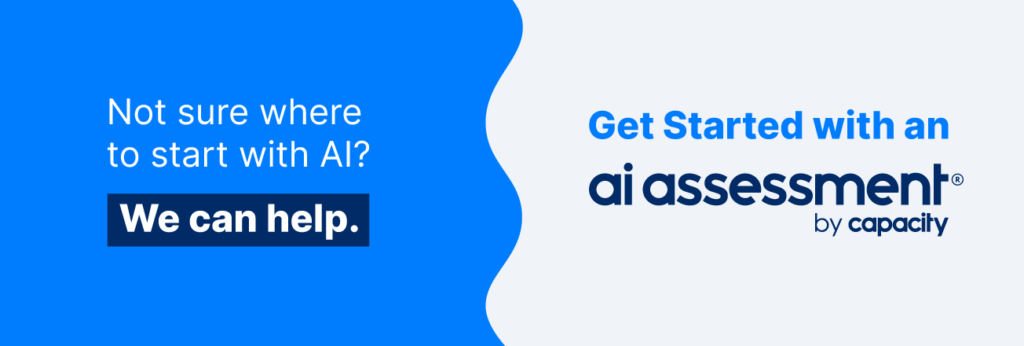Over the past few years, chatbots have rapidly become a major trend in digital marketing. Around the world, more than 1.4 billion users have taken advantage of automated chat features as part of their online experience. It’s now considered one of the most rapidly growing digital marketing channels.
But not all chatbots are created equal. When looking for a solution, you’ll need to understand the difference between rule-based and AI-powered chatbots, which are the two major categories under consideration. Let’s dig into their nuances.
What is the difference between rule-based and AI-powered chatbots?
Rule-based chatbots depend on keywords in the questions they receive to understand the queries. Then, the chatbot will research predefined answers to provide a relevant response.
On the other hand, AI software-powered chatbots use both machine learning and NLP to provide a more conversational experience. AI-powered chatbots also learn with more interactions using a process based on human reasoning.
The pre-defined nature of rule-based chatbots.
Based on the definition above, a rule-based chatbot exists based on a simple if-then concept. In the real world, a user interaction tends to play out like this:
- A customer enters a query about mortgage loan refinancing.
- The chatbot automatically combs through its knowledge base to find any content related to the keyword.
- The answer includes what the rules determine is the most relevant query result.
That rule is always pre-defined. For many rules-based chatbots, the answer depends on keyword density: the content that mentions mortgage loan refinancing most frequently will be the one presented to the user.
A variation of the rule-based chatbot may ask a series of qualifying questions to narrow the search and increase the relevance of the result. The system, though, is based on the same general process. Everything is predefined, set up through a direct link between the question asked and the answer database the bot can comb through.
The narrow uses of rule-based software.
Chatbots like the example described above have a major example: they’re simple and easy to implement. In exchange, though, they create a more rigid experience that leaves little room for interpretation.
Most significantly, they cannot, by nature, adjust to the conversational nature of any typical chat between a business and its audience. This bot answers only with the database and rules that a human has set up for it. Audience intent, natural language nuances, or the broader context of the conversation will play no role in the response. Only the pre-defined interpretation of the words matters.
Two core components of AI-powered chatbots.
In contrast to rule-based chatbots, AI software-powered software creates a more dynamic experience. It, too, has a database of answers with which it can answer audience questions to the best of its ability. The core difference here, though, is that the database and chatbot’s abilities both expand over time.
AI-powered chatbots accomplish that feat through two core technology processes: machine learning and natural language processing.
Machine learning in chatbots.
Among the most simple AI processes, machine learning describes algorithms specifically built to self-improve over time. The algorithm takes in and analyzes data based on the performance of the platform. Over time, it becomes better at learning exactly what worked, and what didn’t, optimizing towards the ideal interaction.
In the real world, that process might look as simple as a bot-originated question asking the user to rate the experience or respond whether the information was helpful. An answer in either direction tells the algorithm valuable information that it will use to improve its answers over time.
NLP in chatbots.
Natural Language Processing, meanwhile, accounts for the human nuances of the average conversation. It allows the chatbot to process the context surrounding even a simple question, using inputs that can range from user credentials to the type of language used. As it answers correctly, it uses these learnings to better account for user intent and gets better answers.
The benefits of NLP are significant. Over time, the software may learn acronyms, spelling errors, and synonyms for popular search words. It can even adjust based on the tone of the question or the chat history. And once again, a ‘helpful/not helpful’ rating system allows the system to learn and improve over time.
The dynamic nature of conversational AI.
Combine the two processes, and you get a dynamic process that gets to the core of conversational AI. The software uses human reasoning to get to a better answer, creating an experience that is almost like talking to a human counterpart. Meanwhile, continuous learnings only improve that experience as the chatbot continues to run.
Which type of chatbot is best?
Asking about the differences between rule-based and AI-powered chatbots will ultimately lead to a simple follow-up question: which is better, and which makes more sense for your business and situation?
Simplicity speaks for rule-based chatbots. They’re easy to implement and tend to cost little if anything. Of course, they also lead to much lower resolution and satisfaction rates. Often, rules-based chatbots are legacy systems from the early age of the technology that simply haven’t been updated yet.
AI-based chatbots are more complex. At the same time, they’re powered for complexity. They can still answer simple questions but are more naturally integrated into more complicated and nuanced interactions, as well. The machine learning, NLP, and conversational AI capabilities tend to make them a better fit for companies looking to truly leverage chat as a core communication channel.
Building AI-based chatbots to power your communications.
The word chatbot is beyond the buzz phase. It’s no longer enough to simply implement the first one you can find, and hope for the best. Instead, finding a solution that benefits your business, your situation, and your audience is crucial to long-term success in this medium. Often, and for the reasons highlighted above, that solution tends to be an AI-powered chatbot.



